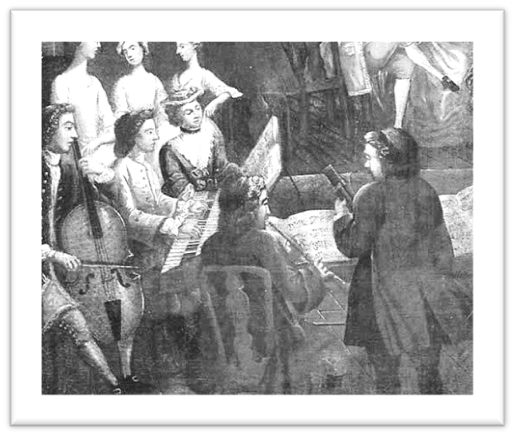What is a Trio Sonata?
The Trio Sonata genre dates back to the Baroque period – it was a very popular format between about 1600-1750. Despite its name, the Trio Sonata is a composition written for four instruments. It is called a “trio”, because there are three written parts, and the fourth instrument provided the “continuo”, or accompaniment.
The format of the written parts is usually two high pitched instruments and one bass instrument. A typical set up would have been two violins, a cello and harpsichord.
The bass part contained a bass part, and also a figured bass line, which would have been “realised” by the harpsichord player, so the bass line tune was actually played by two separate instruments (e.g. cello and harpsichord).
Any of the typical instruments at the time could feature in a trio sonata. These include the violin, viola, cello, flute, oboe, bassoon and recorder.
Here is a painting from the Baroque period, showing what the ensemble could have looked like:

The texture of music in a Trio Sonata is usually contrapuntal. This means that each instrument is equally important, and the music is created by an intertwining of rhythmically independent parts. You can also find homophonic movements in Trio Sonatas, where the instruments work together, playing the same rhythms, creating chords.
The ABRSM Trio Sonata Question

In the ABRSM grade 8 exam, you will be given about a page’s worth of score, with several empty bars in the upper two parts.
The bass line and figured bass line are provided, along with some material at the start, and occasional bars or parts of bars throughout the piece.
Your job is to the fill in the blanks!
You will need to:
- Follow the given harmony shown in the figured bass.
- Respect the style of the period, which includes obeying the rules of Baroque harmony.
- Find and reuse patterns and sequences which are already on the page.
- Invent your own material which should sound convincingly Baroque.
If you have already taken or studied grades 6 and 7 ABRSM music theory, you will be well-prepared for understanding the figured bass aspect. The figures will normally contain some 7th chords and some suspensions, as well as various modulations. You will need to know how 3-part harmony differs from 4-part harmony.
Recognising patterns and sequences is important. Not only will you gain more points in the exam if you use patterns successfully, but also it will be easier to complete the exercise if patterns are used.
It is really important to do plenty of practice before taking the exam. While doing practice questions and past exam papers is, of course, essential, one of the most useful things you can do is listen. You can only expect to write something which sounds like a Trio Sonata, if you have plenty of experience of listening to the genre. Educate your ear through listening – even better, following the score at the same time – and your brain will subconsciously begin to sort out what is right/wrong according to the style.
If you have any music notation software, try transcribing a Trio Sonata with it – you will pick up lots of tips that way! You will notice the frequency of sequences, typical melodic patterns, key changes and much more.
Use Youtube for recordings and imslp.org for scores. Some of the typical composers of this genre are Corelli, Telemann, Handel, Vivaldi, Tartini, Quantz, Gluck, Albinoni and Buxtehude. (By the way, in performance, the soloists would have used a considerable amount of ornamentation (trills, turns and so on) of their parts, particularly in slow movements, so don’t be surprised if what you hear doesn’t match exactly what’s written in the score! Ornamentation wasn’t really included on the score itself at this time – the performers were supposed to show their skill by improvising ornaments as they played.)